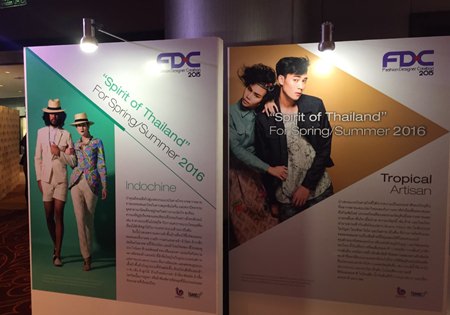BANGKOK, 28 April 2015 – Planning to make Thailand the fashion hub of the ASEAN region by 2017, the Department of Industrial Promotion (DIP) is working hard to enhance the growing success of the Thai Fashion Industry from the emerging designers to the established fashion houses and to encourage the combination of local Thai arts with the creative ideas of the country’s best designers. At present four fashion concepts have been proposed for designers to use as guidelines.
Arthit Wuithikaro, DIP Director said that the DIP recognizes the importance of Thailand’s fashion industry, as it was worth over 620 billion baht in 2014 and has a continuous expansion rate of around 4-5% a year. Within five years the market value of the fashion industry in Thailand is expected to reach a trillion baht.

Despite the on-going growth in the value of the fashion industry in Thailand, the DIP would also like the kingdom to be the fashion hub of ASEAN. This aim is intended to cover all the supply chains in the industry.
Mr. Arthit said that starting with the supply chain upstream, the manufacturing and processing standards must be checked for quality, while the production and choice of each fabric must be appropriate to the design and usage. Raw materials should be developed to exhibit special properties, such as being waterproof; fabrics could be created to offer improved airflow, or have special colors that comply with the demand. Thai people should also focus on manufacturing materials that the country is good at, such as color enhancement, gem stone polishing, Thai silk weaving and creating many other materials.
Further downstream, the DIP would like to develop Thai designers even further. Previously designers created their own unique product that came purely from their resourceful minds. Mr. Arthit stresses however, that “Doing fashion is not about satisfying the needs of oneself, but rather satisfying the needs of the consumers, so we must develop designs that go along with the trends.” In clothing, trends come and go. So designers must stay in tune with news events and youthful attitudes and respond to changes in the world and adapt their designs to trends in popular culture.
As for the arising fashion trends, Mr. Arthit said that there are four main themes: first is the Tropical Artisan which is fashion inspired by nature, using raw materials that reflect a combination of natural beauty and craftsmanship such as hand-woven fabrics and natural dyes that emhance the purity of the materials, such as cotton, silk or hemp. Echoing the natural spirit of “Eco Fashion” at its source, Tropical Artisan also features a large variety of exotic skins that are the natural gems of the region, from alligator skin to stingray and tilapia in natural tones such as orange, indigo, and various shades of green.

SnookSnan – An image befitting “THE STREET,” SnookSnan takes on the carefree personality and lively attitude of the Thai people and the street style seen in buzzy outdoor markets such as Chatuchak. Bold colors such as bright orange, techno green, and denim blue are used with a combination of both light-weight and heavy-duty fabrics such as jeans, bleached fabrics, stretchy cotton, vivid leather as well as plaid fabrics and graphic prints on casual pieces. Styling revolves around matching cool casual pieces with designer brand items, as well as a modification of second-hand pieces.
Indochine – The melting pot of ethnicities and cultures in Thailand and Southeast Asia is reflected in a unique style of colonial era buildings – known as Chino-Portuguese architecture. Materials that reflect diverse cultural roots in “THE HERITAGE” such as tribal handicrafts and ancient embroidery techniques are used alongside classic European fabrics and leather in a dark, subdued palette. A good example is gabardine and luxurious twisted yarn as a shirting fabric used with local hand-woven silk in vivid shades of orange, gold, emerald green and ruby.
Gender Futurism – The trend is a reflection of the social and cultural complexity in modern cultures. Brewed from the conflicting idea of acceptance and resistance of gender diversity, Gender Futurism explores the fading line between menswear and women’s wear through materials and color palette. Textures of the fabrics exhibit raw, rough and glossy structures as well as a certain textural complexity that comes with a smooth feel. The fabrics are most suitable for outfits for special occasions in THE SALON.
Mr. Arthit pointed out that for young designers to climb the ladder to international acceptance, it is not only through the implementation of culture, wisdom, or talent but the desire to understand the trends of the world. These four themes will be the emerging trends of the world certified by world’s fashion gurus.
Interested designers out there, who would like to learn more about fashion and would like to participate in activities provided by the DIP, and who wish to have a greater prominence in the Thai fashion industry, should contact 02-367-8296, or logon to www.dip.go.th or www.facebook.com/dip.pr.





